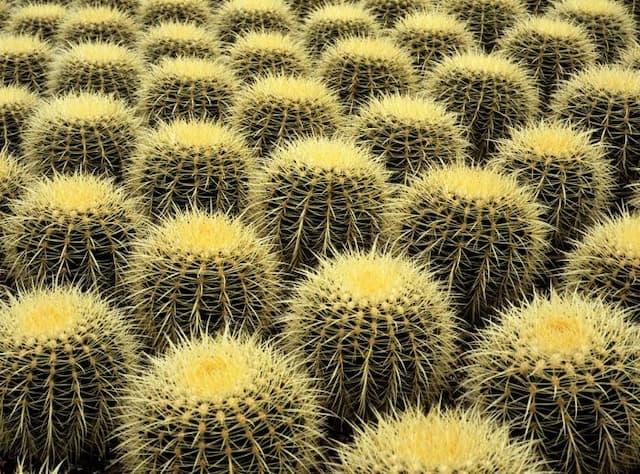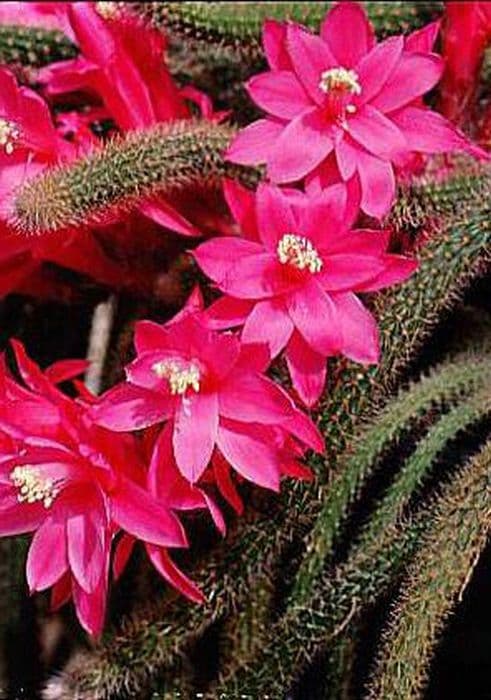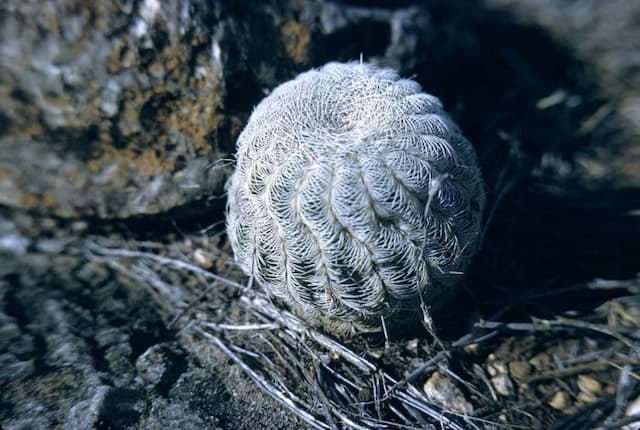Spiny pincushion cactus Mammillaria spinosissima

ABOUT
M. spinosissima is a cactus with usually solitary cylindrical stems to 30cm tall and 10cm diameter, with bristly red-brown or white central spines, cream radials and carmine-pink flowers 2cm long
About this plant
 Names
NamesFamily
Cactaceae
Synonyms
Red-Headed Irishman, Spiny Pincushion Cactus
Common names
Mammillaria centraliplumosa, Mammillaria haageana subsp. spinosissima, Mammillaria pilcayensis, Mammillaria spinosissima subsp. tepoxtlana, Mammillaria spinosissima subsp. pilcayensis, Mammillaria spinosissima subsp. tepoxtlensis, Neomammillaria spinosissima.
 Characteristics
CharacteristicsLife cycle
Perennials
Foliage type
Evergreen
Color of leaves
Green
Flower color
Pink
Height
1 foot (0.30 meters)
Spread
6 inches (0.15 meters)
Plant type
Cactus
Hardiness zones
9
Native area
Mexico
Benefits
 General Benefits
General Benefits- Easy to care for: Mammillaria spinosissima, commonly known as the Red-Headed Irishman, is low maintenance and suitable for beginners.
- Drought tolerant: This cactus is highly adapted to dry conditions, requiring infrequent watering.
- Aesthetically pleasing: With its distinctive spines and colorful flowers, it can add visual interest to any collection or garden.
- Space-saving: Being a small to medium-sized plant, it is ideal for small spaces or as part of a terrarium or dish garden.
- Pollinator friendly: When in bloom, the flowers attract bees and other pollinators, supporting local ecosystems.
- Long-lived: Cacti, including the Red-Headed Irishman, can live for many years with proper care.
- Non-toxic: This plant is safe to keep around pets and children as it is not toxic if ingested.
- Therapeutic hobby: Caring for cacti can be a relaxing and rewarding hobby, promoting mindfulness and stress relief.
 Medical Properties
Medical PropertiesThis plant is not used for medical purposes.
 Air-purifying Qualities
Air-purifying QualitiesThis plant is not specifically known for air purifying qualities.
 Other Uses
Other Uses- Mammillaria spinosissima, commonly known as Red-headed Irishman, can be used as a natural barrier due to its spiny exterior, deterring animals and unauthorized entry into private areas.
- In some cultures, the Red-headed Irishman is grown as a charm believed to ward off negative energy and bring about good luck to the household.
- The unique aesthetic of the Red-headed Irishman makes it a popular choice for botanical illustration and photography, enhancing portfolios with its vivid appearance.
- It is sometimes used as a didactic tool in educational settings, such as schools and botanical gardens, to teach about desert flora and adaptation strategies of succulents.
- This plant is an option for xeriscaping, which is a landscaping method that reduces or eliminates the need for irrigation.
- Red-headed Irishman's striking form and coloration are used in fashion design and home decor as a motif or inspiration for patterns and textiles.
- In artisan crafts, the image or silhouette of Mammillaria spinosissima is incorporated into jewelry designs, ceramics, and even embroidery.
- The plant's resilience and low maintenance make it an ideal gift for plant enthusiasts, particularly beginners looking to start a cacti collection.
- Due to its slow growth and compact size, Red-headed Irishman can be utilized in miniature gardening and fairy garden arrangements, creating a desert-themed landscape on a small scale.
- Its presence in an office or workspace is used to add a touch of nature's resilience, often touted as a reminder of persistence and endurance in harsh conditions.
Interesting Facts
 Feng Shui
Feng ShuiThe Red-headed Irishman is not used in Feng Shui practice.
 Zodiac Sign Compitability
Zodiac Sign CompitabilityThe Red-headed Irishman is not used in astrology practice.
 Plant Symbolism
Plant Symbolism- Resilience: Mammillaria spinosissima, commonly known as the Red-Headed Irishman, often symbolizes resilience due to its ability to thrive in harsh, arid environments and adapt to scarce water conditions.
- Protection: The numerous spines of the Red-Headed Irishman serve as protection against herbivores, symbolizing a need for defense and personal boundaries.
- Independence: This plant's ability to survive with minimal care represents independence and self-sufficiency.
- Endurance: Its long-lasting nature and persistent growth habits convey a sense of endurance and the ability to persist through challenges.
- Beauty and Danger: The Red-Headed Irishman's striking appearance, juxtaposed with its sharp spines, symbolizes the balance between beauty and danger, cautioning against judging by appearances alone.
 Water
WaterThe Red-headed Irishman cactus should be watered thoroughly, but infrequently, allowing the soil to completely dry out between waterings. During the growing season, typically from spring to early fall, watering once every 7 to 10 days with about 8-12 ounces of water, depending on the pot size, is sufficient. In the winter, reduce watering to once a month or less, as the plant goes into dormancy. Water directly onto the soil and avoid wetting the cactus body to prevent rot.
 Light
LightThe Red-headed Irishman cactus thrives in bright, indirect light and can tolerate direct sunlight, especially in the morning. A south-facing or east-facing window is an ideal spot for this cactus, providing it with plenty of light without the harsh afternoon sun that could potentially scorch it.
 Temperature
TemperatureThe Red-headed Irishman cactus prefers temperatures between 70°F and 80°F during its active growing season and can survive a minimum temperature of 40°F. It is important to protect the cactus from frost, as temperatures below 32°F can cause damage to the plant. The ideal temperature range ensures healthy growth and flowering.
 Pruning
PruningPruning is generally not required for the Red-headed Irishman cactus, except to remove any dead or damaged spines or to maintain its shape. If needed, pruning should be done carefully with tongs or gloves to protect your hands from the spines, usually in the spring at the onset of the growing season.
 Cleaning
CleaningAs needed
 Soil
SoilThe best soil mix for Red-headed Irishman (Mammillaria spinosissima) is a well-draining cactus mix with added perlite or pumice to increase aeration; a pH of around 5.5 to 6.5 is ideal for this cactus.
 Repotting
RepottingRed-headed Irishman should be repotted every two to three years or when it has outgrown its pot, to provide fresh nutrients and prevent rootbound conditions.
 Humidity & Misting
Humidity & MistingRed-headed Irishman thrives in low humidity conditions typical of arid environments, avoid high humidity to reduce the risk of rot.
 Suitable locations
Suitable locationsIndoor
Place in bright, indirect light and ensure pot has drainage.
Outdoor
Full sun to partial shade, protect from excessive rain.
Hardiness zone
9b-11 USDA
 Life cycle
Life cycleMammillaria spinosissima, commonly known as Spiny Pincushion Cactus, starts its life as a seed that needs well-draining soil and warm temperatures to germinate. The seedling stage follows, characterized by the emergence of tiny spines and the beginning of a tubercle development, which is a distinctive feature of the Mammillaria genus. As the plant grows into a juvenile, it forms a columnar stem and more pronounced spines, and may start to cluster by producing offsets around its base. Upon reaching maturity, the Spiny Pincushion Cactus produces vibrant red or pink flowers from the crown of the stem, which open in daylight and may lead to pollination and fruit development. The fruit of this cactus is berry-like, containing seeds that can be dispersed to propagate the next generation of plants. Over the years, Mammillaria spinosissima can become quite large and develop a densely spined, impressive columnar shape, living many decades under the right conditions.
 Propogation
PropogationPropogation time
Spring-Early Summer
The most popular method of propagating the Red-Headed Irishman cactus, Mammillaria spinosissima, is through the use of offsets. These small bulb-like growths form naturally at the base of the parent plant. When they have developed a sizeable root system, which most often happens in the spring or early summer, they can be gently twisted off and allowed to dry for a few days to let the cut end callous over. Once dry, plant the offset in a cactus potting mix, watering lightly initially to prevent root rot. Keep the soil only moist and provide bright, indirect light until new growth indicates that the offset has established a strong root system, after which it can be treated as an adult plant.









